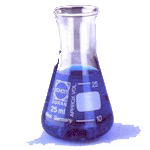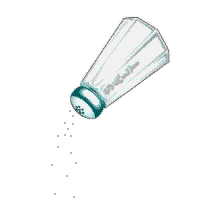Acids and bases
- In a nutshell:
- Acids are electron stealers and have a very low pH
- Bases are electron donors and have a very high pH.
- Salts occur when an acid and base mix
Earlier, we discussed ions and properties of the elements. The electron arrangement explains why some chemicals are givers and some are takers. We have special names for strong givers and strong takers. They are bases and acids.
 Acids
Acids
Simply put, acids are the takers in the game of electron swiping. A kinder way to say this is an "electron receiver." Often, acids are characterized by an excessive amount of H+ ions, which are also called hydrions. The hydrions can rip electrons from other substances. This is why acids can dissolve things. It literally rips the electrons away. When hydrochloric acid is dumped into water, it separates from HCl into H+ and Cl- ions. The chlorine hangs out in the water and changes little, but the hydrogen in the water can accept electrons. This makes hydrochloric acid... well... an acid. You have this acid in your stomach.
Another strong acid is sulfuric acid, also called H2SO4. When this acid breaks apart into its ions, The first H+ detaches easily. The other H+ can also detatch, making sulfuric acid particularly strong and dangerous. This powerful acid can be found in car batteries. It can eat through metal, clothes and skin.
Many acids aren't as dangerous as hydrochloric and sulfuric acids. Some are actually pleasant to eat. Citric acid is found in fruits such as oranges and lemons. Amino acids make up protein. Fatty acids make up fats. Some of these acids end with -COOH, or a carbon, two oxygens and a hydrogen. This weak acid is found in many substances.
Water is actually considered a very weak acid. While most water stays together, a little bit of it breaks down into H+ and OH- ions. While these are opposites (one is an acid and one is a base) the H+ seems to be a little stronger.
As a general rule, acids tend to be sour, conduct electricity, and react with bases. When you put them with litmus, a pH indicator, the litmus turns red.
 Bases
Bases
You can think of bases as the opposites of acids. They are the givers - sometimes violently so. Often, though not always, bases have a lot of OH- ions. These are able to give away an electron, or at least make other substances less positive. Like an acid, this strong charge can also rip things apart, and a strong base can be as dangerous as a strong acid.
Because most foods are composed of acids, bases make great cleaning products. Bases can tear apart amino acids and fatty acids to remove them from fabrics. This is why bases are used as cleaning solutions. Common cleaners are very often violent givers.
Bases that may be around your home include ammonia, which is found in window sprays and most cleaners, sodium hydroxide (NaOH) which is found in drain cleaners, and ordinary soaps and shampoos. Characteristics of bases include being slippery to the touch, having a bitter taste, conducting electricity (all ions can) and turning litmus blue. Bases react strongly with acids.
The pH Scale
It is possible to measure how strong an acid or a base is. Using a horrible amount of mathematics involving inverse exponents, scientists were able to create a scale to measure how acidic something is. This is called the pH scale, which is short for per Hydrion.
The scale ranges from a pH of 0 on the acid side to a ph of 14 on the base side. The further toward the middle something is, the more neutral it is.
| 0 |
1 |
2 |
3 |
4 |
5 |
6 |
7 |
8 |
9 |
10 |
11 |
12 |
13 |
14 |
- Common substances and their pH:
- H2SO4 = 0
- Lemon juice = 2
-
Acid Rain = 4
-
Coffee = 5
-
Pure Water = 7
-
Baking Soda = 9
-
Soapy water = 12
-
Drain Cleaner = 14
 Salts
Salts
When an acid and base get together, they neutralize each other. Usually this forms water and a salt. The water makes sense, especially because a H+ together with an OH- would result in a neutral H2O. The salt is the result of the other parts of the equation getting together. For example, when HCl mixes with NaOH, The result is H2O and NaCl, or table salt. (I've heard of one teacher actually mixing equal parts together and drinking them in front of a class, but I would NOT recommend this.) Potassium salts, sulfur salts, or others could be made too.
A salt is very different than an acid or a base. Salts have a neutral pH. They are usually very stable and don't mix all that well. In water, they will separate to form ions, but the water remains neutral as long as the ions are balanced.
 Acids
Acids Bases
Bases Salts
Salts